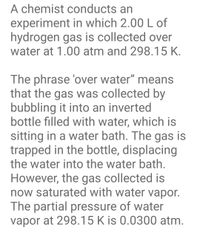
Chemistry
10th Edition
ISBN: 9781305957404
Author: Steven S. Zumdahl, Susan A. Zumdahl, Donald J. DeCoste
Publisher: Cengage Learning
expand_more
expand_more
format_list_bulleted
Question
Using Dalton's law, calculate the pressure of the hydrogen gas in atm

Transcribed Image Text:**Title: Collecting Hydrogen Gas over Water**
**Experiment Overview:**
In this experiment, a chemist collects 2.00 liters of hydrogen gas by utilizing the method known as "over water." The conditions for this collection are set at a pressure of 1.00 atm and a temperature of 298.15 K.
**Concept Explanation:**
- **'Over Water' Collection Method:**
- The phrase "over water" describes a technique where gas is gathered by bubbling it into an inverted container submerged in a water bath.
- The contained gas displaces the water, allowing it to be trapped within the inverted bottle.
**Important Considerations:**
- The gathered gas is saturated with water vapor due to the presence of water in the setup.
- At the specified temperature of 298.15 K, the partial pressure of the water vapor is 0.0300 atm.
This method is valuable for obtaining gases in laboratory settings, though it is essential to account for the water vapor's partial pressure when calculating the collected gas's properties.
Expert Solution
This question has been solved!
Explore an expertly crafted, step-by-step solution for a thorough understanding of key concepts.
This is a popular solution
Trending nowThis is a popular solution!
Step by stepSolved in 3 steps

Knowledge Booster
Learn more about
Need a deep-dive on the concept behind this application? Look no further. Learn more about this topic, chemistry and related others by exploring similar questions and additional content below.Similar questions
- What mass of gas’s left the tube in the scenario?arrow_forwardExplain why temperature and volume have a direct relationship. Explain why number of moles and volume have a direct relationship.arrow_forwardWhat are the values of temperature and pressure used for standard temperature and pressure?arrow_forward
- Charles' Law is an empirical gas law relationship that describes O a. the direct proportionality between V and T O b. the inverse proportionality between V and T C. the inverse proportionality between P and T d. the direct proportionality between P and Tarrow_forwardUse the References to access important values if needed for this question. A sample of hydrogen gas has a density of g/L at a pressure of 1.20 atm and a temperature of 53 °C. Assume ideal behavior. Submit Answer Retry Entire Group 9 more group attempts remainingarrow_forwardA 25.5 liter ballon holding a 3.5 moles of carbon dioxide leaks. If we are able to determine that 1.9 moles of carbon dioxide escaped before the container could be sealed, what is the new volume of the container?arrow_forward
- Need answer to the last two questions only.arrow_forwardA 3.75 L sample of O2 at STP contains what mass of O2? A. 5.34 g B. 16.0 g C. 4.99 g D. 11.2 garrow_forward1 mole sample of helium gas is cooled until its volume is measured to be 10.5 L. What is the temperature of the gas in Kelvinarrow_forward
arrow_back_ios
arrow_forward_ios
Recommended textbooks for you
 ChemistryChemistryISBN:9781305957404Author:Steven S. Zumdahl, Susan A. Zumdahl, Donald J. DeCostePublisher:Cengage Learning
ChemistryChemistryISBN:9781305957404Author:Steven S. Zumdahl, Susan A. Zumdahl, Donald J. DeCostePublisher:Cengage Learning ChemistryChemistryISBN:9781259911156Author:Raymond Chang Dr., Jason Overby ProfessorPublisher:McGraw-Hill Education
ChemistryChemistryISBN:9781259911156Author:Raymond Chang Dr., Jason Overby ProfessorPublisher:McGraw-Hill Education Principles of Instrumental AnalysisChemistryISBN:9781305577213Author:Douglas A. Skoog, F. James Holler, Stanley R. CrouchPublisher:Cengage Learning
Principles of Instrumental AnalysisChemistryISBN:9781305577213Author:Douglas A. Skoog, F. James Holler, Stanley R. CrouchPublisher:Cengage Learning Organic ChemistryChemistryISBN:9780078021558Author:Janice Gorzynski Smith Dr.Publisher:McGraw-Hill Education
Organic ChemistryChemistryISBN:9780078021558Author:Janice Gorzynski Smith Dr.Publisher:McGraw-Hill Education Chemistry: Principles and ReactionsChemistryISBN:9781305079373Author:William L. Masterton, Cecile N. HurleyPublisher:Cengage Learning
Chemistry: Principles and ReactionsChemistryISBN:9781305079373Author:William L. Masterton, Cecile N. HurleyPublisher:Cengage Learning Elementary Principles of Chemical Processes, Bind...ChemistryISBN:9781118431221Author:Richard M. Felder, Ronald W. Rousseau, Lisa G. BullardPublisher:WILEY
Elementary Principles of Chemical Processes, Bind...ChemistryISBN:9781118431221Author:Richard M. Felder, Ronald W. Rousseau, Lisa G. BullardPublisher:WILEY

Chemistry
Chemistry
ISBN:9781305957404
Author:Steven S. Zumdahl, Susan A. Zumdahl, Donald J. DeCoste
Publisher:Cengage Learning

Chemistry
Chemistry
ISBN:9781259911156
Author:Raymond Chang Dr., Jason Overby Professor
Publisher:McGraw-Hill Education

Principles of Instrumental Analysis
Chemistry
ISBN:9781305577213
Author:Douglas A. Skoog, F. James Holler, Stanley R. Crouch
Publisher:Cengage Learning

Organic Chemistry
Chemistry
ISBN:9780078021558
Author:Janice Gorzynski Smith Dr.
Publisher:McGraw-Hill Education

Chemistry: Principles and Reactions
Chemistry
ISBN:9781305079373
Author:William L. Masterton, Cecile N. Hurley
Publisher:Cengage Learning

Elementary Principles of Chemical Processes, Bind...
Chemistry
ISBN:9781118431221
Author:Richard M. Felder, Ronald W. Rousseau, Lisa G. Bullard
Publisher:WILEY